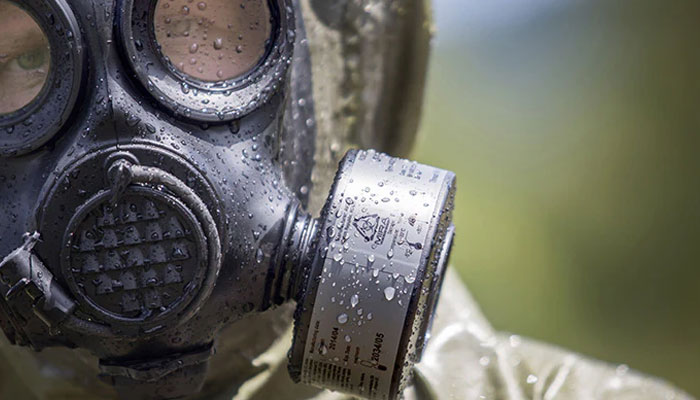
Proper gas mask filter storage and replacement is crucial for ensuring the effectiveness of the mask in protecting against harmful gases. This involves proper storage conditions, regular inspections, and timely replacement of expired or damaged filters. Failure to do so can result in serious health risks to the user.
Storing
Many preppers add gas masks to their survival gear collection because they offer protection against a wide range of toxic materials. However, the protection offered by these masks will wear off over time, and it is important to keep these filters in good condition so that they can continue to work when needed.
A gas filter only works for a limited amount of time before the carbon granules become saturated, at which point they will start to let through all pollutants with which they come into contact. A gas filter must be replaced before this happens, or it will not be effective in an emergency.
The problem is that most people who buy gas masks and filters do not understand the intricacies of how these devices are designed to work. For example, many older types of filters used military surplus equipment that relied on chemical reactions to remove toxic substances from the air (for example, chlorine gas in World War I or phosgene in World War I). Modern filter systems use a different technique that binds the toxins to the substrate of the filter. This method is much more effective and requires no chemical reactions.
Because of this, it is important to purchase and store your filters from reputable suppliers who are knowledgeable about their products. This will help ensure that you are getting a high-quality filter that is likely to be useful in an emergency situation. It is also important to avoid purchasing surplus filters that are not GOST tested, as they may contain old and potentially hazardous contaminants (like asbestos or chromium).
In addition, it is important to select filters that are compatible with your specific mask and that are stored properly. A mask should be stored in a cool, dry place without temperature extremes and should not be subjected to excessive stress. A mask that is not stored correctly can develop cracks or holes in the shell, which could compromise the integrity of the filter.
Buying the best gas mask filters for your bug-out bag is a life-saving decision that takes only a few minutes. If you have the right supplies on hand, a gas mask will be an invaluable part of your survival kit in the event of a disaster, and don’t forget to consider Accessories Promo Codes for potential savings on these essential supplies.
Cleaning
A gas mask is an important part of any disaster preparedness plan. However, just owning a gas mask is not enough; it must be properly inspected, cleaned, and decontaminated regularly. Failure to do so could result in serious consequences.
The process of inspecting a gas mask involves disassembling it completely and thoroughly looking at all the parts to ensure they are in good working order. This can take some time, so it is important to have a workspace that is clean and well-lit to make the job easier. If possible, try to display your masks behind a screen or in a glass-fronted cabinet to prevent sunlight from damaging them.
Once the inspection is complete, the next step in cleaning a gas mask is to remove and wash all of the components. This includes the filters, demand valve assemblies, and hoses. You can use a mild dishwashing detergent to wash the parts, but be careful not to get the harness wet. Getting the harness wet will negatively affect its ability to seal to your face when wearing it and also make breathing through the filter more difficult.
After washing the mask and all of its components, it is important to allow them to dry completely before reassembling. Moisture will cause the rubber lining and head straps to deteriorate and can create leakage points where hazardous chemicals or gases could enter. It is also important to dry the mouthpiece of the mask, which is often made from a plastic resin that can be easily damaged by moisture.
During the drying process, it is important to use a cloth or paper towel that has been soaked with 3oz of 90% ISO alcohol. This is a standard chemistry solvent that can be purchased online and in most hardware stores. Use this solution to wipe down the entire inside and outside of the mask, focusing on areas where it comes into contact with your face. Once the mask is dry, reassemble it and be sure to leave it in a cool place to avoid any temperature extremes that could adversely affect its functionality.
Testing
Modern protective gas masks are a technological marvel. They start with carbon filter media, whose enormous surface area traps and holds tiny particles and toxins. The filter is impregnated with a precise blend of metal salts and subjected to multiple other tests to ensure it’s effective. This is an extremely labor-intensive process that requires years of experience to master consistently. Then the filter is surrounded by layers of other elements that protect against a wide range of contaminants, gases, and particles. The result is an extraordinarily versatile and dependable device that could save a person’s life in the event of a chemical attack or other disaster.
The NBC-77 SOF filter, for instance, offers protection against nearly 300 different chemicals and toxins including radioactive substances, mercury, low-boiling organics, tear-producing agents, harmful microorganisms, NOx, and carbon monoxide. The filters are also color-coded to indicate what kinds of toxins and compounds they can effectively filter out, making them easy for first responders and civilians alike to recognize and use in an emergency.
As far as the face mask goes, there are a variety of styles available depending on what type of environment you’re expecting to be operating in. Some are designed to allow the wearer to see, while others are strictly for air filtration. Most have circular lenses that can be replaced with corrective ones if necessary. In general, the lenses are made from either a single glass or mica lens or a Triplex style (a cellulose acetate lens sandwiched between two glass lenses), and you can explore MIRA Safety Coupon Codes for potential savings on these different styles.
In any case, the masks need to be properly fit before being used. This can be done by conducting a negative pressure test and a positive pressure test. Negative pressure testing involves blocking the inlet ports on the mask with your hands and breathing in and out, paying attention to any air escaping around the edges of the face mask. A correctly fitted mask won’t have any leaks at all.
It’s also important to note that each filter has a limited service life before it needs to be changed out. Using a filter after its effective service time has passed is called “breaking through” and will not provide you with adequate protection in the event of an emergency. Most NATO-compatible filters are good for up to 8 hours of continuous use and will warn you when they’re beginning to load up by displaying symptoms such as an unpleasant smell or taste, restricted breathing, or a decrease in filtration efficiency.
Replacement
A gas mask is only as good as the filter that is in it. The best filters are a combination of chemical and mechanical media that can provide protection from a variety of threats. These filters need to be able to be replaced and have a shelf life. When a filter is replaced, it needs to be done properly so that contaminants don’t get inhaled in the process. Changing a filter isn’t something that can be done on the fly in a stressful situation.
When you are purchasing a new filter, make sure it is labeled as CBRN-certified. This means it is certified to protect against several different chemicals, biological agents, and nuclear/radiological agents. This is an important distinction because there are a lot of low-quality surplus masks out there that can be purchased at gun shows and online. The problem is that these old surplus masks can be very dangerous to wear and only offer limited if any, protection in the event of a disaster.
Using an improper storage location for your gas mask filters can also degrade them over time. They should be kept in a cool, dark, dry area away from temperature extremes. The filters should also be stored in a way that minimizes the amount of moisture in them. This can be accomplished by vacuum sealing the filters to eliminate any air that could potentially seep in. Some manufacturers even package the filters in these bags, so that they can be easily transported and stored.
You should also make sure that you have plenty of replacement filters in stock, especially if you are planning to use the filter in the field. You should have the ability to change a filter on the fly, without having to take off the entire mask, to be prepared for any situation that may arise. Lastly, you should practice changing the filter with the mask on, so that you can do it in a fast and efficient manner when it is actually needed.
While the chances of needing a gas mask during an emergency are extremely slim, it is still one of the most critical pieces of equipment that you can add to your survival collection. The right mask and filter can be the difference between life and death in a crisis, so make sure you are ready for any scenario by properly storing and maintaining your filters.
Conclusion
Proper gas mask filter storage and replacement is crucial for maintaining the effectiveness of the mask. Failure to do so can lead to serious health risks and even death. It is important to regularly check and replace filters, and store them in a cool, dry place. Don’t compromise on safety – take the necessary steps to ensure your gas mask is always ready for use.








